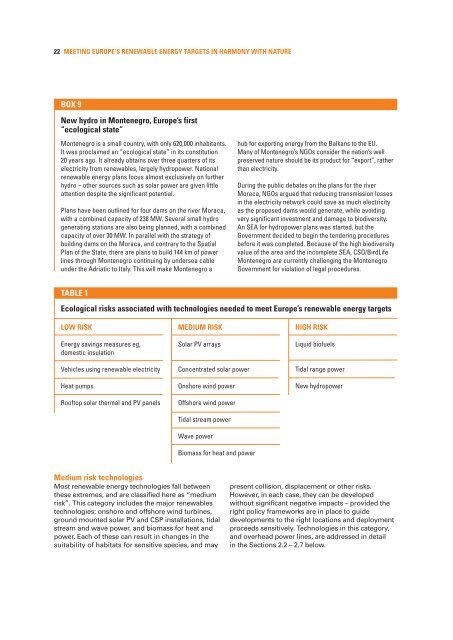Meeting Europe's renewable energy targets in harmony with - RSPB
Meeting Europe's renewable energy targets in harmony with - RSPB
Meeting Europe's renewable energy targets in harmony with - RSPB
You also want an ePaper? Increase the reach of your titles
YUMPU automatically turns print PDFs into web optimized ePapers that Google loves.
22 MEETING EUROPE’S RENEWABLE ENERGY TARGETS IN HARMONY WITH NATURE<br />
BOX 9<br />
New hydro <strong>in</strong> Montenegro, Europe’s first<br />
“ecological state”<br />
Montenegro is a small country, <strong>with</strong> only 620,000 <strong>in</strong>habitants.<br />
It was proclaimed an “ecological state” <strong>in</strong> its constitution<br />
20 years ago. It already obta<strong>in</strong>s over three quarters of its<br />
electricity from <strong>renewable</strong>s, largely hydropower. National<br />
<strong>renewable</strong> <strong>energy</strong> plans focus almost exclusively on further<br />
hydro – other sources such as solar power are given little<br />
attention despite the significant potential.<br />
Plans have been outl<strong>in</strong>ed for four dams on the river Moraca,<br />
<strong>with</strong> a comb<strong>in</strong>ed capacity of 238 MW. Several small hydro<br />
generat<strong>in</strong>g stations are also be<strong>in</strong>g planned, <strong>with</strong> a comb<strong>in</strong>ed<br />
capacity of over 30 MW. In parallel <strong>with</strong> the strategy of<br />
build<strong>in</strong>g dams on the Moraca, and contrary to the Spatial<br />
Plan of the State, there are plans to build 144 km of power<br />
l<strong>in</strong>es through Montenegro cont<strong>in</strong>u<strong>in</strong>g by undersea cable<br />
under the Adriatic to Italy. This will make Montenegro a<br />
hub for export<strong>in</strong>g <strong>energy</strong> from the Balkans to the EU.<br />
Many of Montenegro’s NGOs consider the nation’s well<br />
preserved nature should be its product for “export”, rather<br />
than electricity.<br />
Dur<strong>in</strong>g the public debates on the plans for the river<br />
Moraca, NGOs argued that reduc<strong>in</strong>g transmission losses<br />
<strong>in</strong> the electricity network could save as much electricity<br />
as the proposed dams would generate, while avoid<strong>in</strong>g<br />
very significant <strong>in</strong>vestment and damage to biodiversity.<br />
An SEA for hydropower plans was started, but the<br />
Government decided to beg<strong>in</strong> the tender<strong>in</strong>g procedures<br />
before it was completed. Because of the high biodiversity<br />
value of the area and the <strong>in</strong>complete SEA, CSO/BirdLife<br />
Montenegro are currently challeng<strong>in</strong>g the Montenegro<br />
Government for violation of legal procedures.<br />
TABLE 1<br />
Ecological risks associated <strong>with</strong> technologies needed to meet Europe’s <strong>renewable</strong> <strong>energy</strong> <strong>targets</strong><br />
LOW RISK<br />
Energy sav<strong>in</strong>gs measures eg,<br />
domestic <strong>in</strong>sulation<br />
Vehicles us<strong>in</strong>g <strong>renewable</strong> electricity<br />
Heat pumps<br />
Rooftop solar thermal and PV panels<br />
MEDIUM RISK<br />
Solar PV arrays<br />
Concentrated solar power<br />
Onshore w<strong>in</strong>d power<br />
Offshore w<strong>in</strong>d power<br />
Tidal stream power<br />
Wave power<br />
Biomass for heat and power<br />
HIGH RISK<br />
Liquid biofuels<br />
Tidal range power<br />
New hydropower<br />
Medium risk technologies<br />
Most <strong>renewable</strong> <strong>energy</strong> technologies fall between<br />
these extremes, and are classified here as “medium<br />
risk”. This category <strong>in</strong>cludes the major <strong>renewable</strong>s<br />
technologies: onshore and offshore w<strong>in</strong>d turb<strong>in</strong>es,<br />
ground mounted solar PV and CSP <strong>in</strong>stallations, tidal<br />
stream and wave power, and biomass for heat and<br />
power. Each of these can result <strong>in</strong> changes <strong>in</strong> the<br />
suitability of habitats for sensitive species, and may<br />
present collision, displacement or other risks.<br />
However, <strong>in</strong> each case, they can be developed<br />
<strong>with</strong>out significant negative impacts – provided the<br />
right policy frameworks are <strong>in</strong> place to guide<br />
developments to the right locations and deployment<br />
proceeds sensitively. Technologies <strong>in</strong> this category,<br />
and overhead power l<strong>in</strong>es, are addressed <strong>in</strong> detail<br />
<strong>in</strong> the Sections 2.2 – 2.7 below.
















